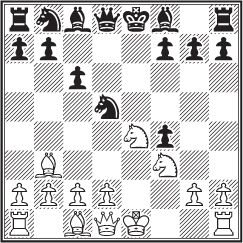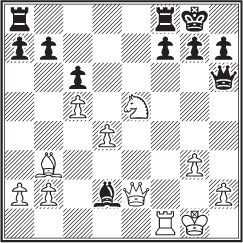
This completes a trilogy begun with Games 68 and 69. In each case Fischer secured an early advantage in space and nursed it into the middle game while his opponent seemed preoccupied. Here the space edge is converted to a winning initiative by move 20.
Fischer – Dragoljub Minić
Vinkovci 1968
Bishop’s Gambit (C33)
1 |
e4 |
e5 |
2 |
f4 |
exf4 |
3 |
♗c4 |
|
The opening books, following musty analysis by Bogolyubov, had maintained for decades that Black gets the edge with 3...♘f6 4 ♘c3 c6 and 5...d5, e.g. 5 ♗b3 d5 6 exd5 cxd5 7 d4 ♗d6 8 ♘ge2 0-0 9 0-0 g5 10 ♘xd5 ♘c6.
But 9 ♗xf4 ♗xf4 10 ♘xf4 ♖e8+ 11 ♘fe2 is the acid test. How this came to light was typically bizarre:
In 1964 Fischer was given carte blanche to write articles for Chess Life. He decided to use the opportunity to analyze the forgotten – deservedly so – games of an 1862 match between Steinitz and the obscure Italian master Serafino Dubois.
In one of the games featuring a Bishop’s Gambit, Fischer continued the analysis from 11 ♘fe2 with 11...♘g4 12 ♘xd5 ♗e6 13 h3 ♗xd5 14 hxg4 ♗xg2 15 ♖h2 ♗f3 16 ♕d3 – working out to mate in one line – and concluded White was much better. Computers disagree – grandmasters have virtually ignored 9 ♗xf4, so Fischer’s analysis remains almost untested after more than 50 years.
3 |
... |
♘e7 |
This idea of Steinitz’s allows Black to decide later between ...d5 or ...♘g6.
4 |
♘c3 |
c6 |
5 |
♘f3 |
d5 |
6 |
♗b3! |
|
This drawback to 3...♘e7 is the lack of pressure on e4. On 6...d4 7 ♘e2 c5 8 ♘g5 and Black is lost.
6 |
... |
dxe4 |
7 |
♘xe4 |
♘d5 |
Black could justify his third move with 7...♘g6? – and be crushed by 8 ♘eg5! ♕e7+ 9 ♔f2.

8 |
♕e2! |
|
More subtle than 8 c4 ♘f6 9 ♘xf6+ ♕xf6 10 0-0 after which 10...♗d6 or 10...c5 is unclear (and 10...♗e7 11 d4 ♘d7 12 ♕e2 g5? allows 13 ♘xg5! ♕xg5 14 ♗xf4 with a powerful attack).
8 |
... |
♗e7 |
9 |
c4 |
♘c7 |
Putting the knight offsides, 9...♘b4 is playing with fire, particularly since 10 d4 ♗g4 11 ♗xf4 ♗xf3 12 gxf3 ♕xd4? loses to the pretty 13 ♖d1 ♕b6 14 ♘d6+ ♔f8 15 ♘c8!.
10 |
d4 |
0-0 |
One of the best things about the King’s Gambit is psychological: Defenders look at White’s short-term tactical threats and Black’s extra pawn – but underestimate White’s space edge.
Here Black should fight for operating room with 10...♗g4! and then 11 c5 0-0 12 ♗xf4 ♘e6 13 ♗xe6 fxe6!, e.g. 14 ♗d6 ♗xd6 15 ♘xd6 ♗xf3 16 gxf3 ♕h4+ 17 ♕f2 ♕h6. In this, and other unplayed variations, Minić fails to appreciate how safe Black is after ...fxe6.
11 |
♗xf4 |
♘e6 |
12 |
♗e3 |
|
Black can minimize the damage with 12...♘d7 and 13...♘f6 but White’s advantage is distinct after 13 0-0 ♘f6 14 ♘xf6+ (or 14 ♘g3 and ♘f5) ♗xf6 15 d5!.
12 |
... |
♗b4+ |
13 |
♔f2!? |
|
White wants to embarrass the bishop with c4-c5 and ♕c4.
13 |
... |
♘d7 |
14 |
c5! |
♘f6 |
15 |
♘xf6+ |
♕xf6 |
16 |
♖hf1 |
♘f4! |
Much better than 16...♖e8 17 ♕c4! ♗a5 18 ♔g1.
17 |
♗xf4 |
♕xf4 |
18 |
g3! |
|
The only bid for a middlegame advantage. For example, 18 ♔g1 ♗g4! (intending ...♗xf3 or ...♖ae8) 19 ♕e5 ♕xe5 20 ♘xe5 ♗e6 is roughly equal.
18 |
... |
♕h6 |
White carries out his idea after 18...♕f6 19 ♔g2 ♗g4 20 ♕c4!, threatening ♘e5 as well as ♕xb4. Black can avoid material loss with 20...♕e6! but is worse (21 ♕xb4 ♕e2+ 22 ♖f2 ♗xf3+ 23 ♔g1 ♕e4 24 ♖e1).
19 |
♔g1 |
|
The idea of an Exchange sacrifice must have occurred to White when he examined 19 ♕e7 ♗h3 and saw that 20 ♔g1! ♗xf1 21 ♖xf1 ♕f6 22 ♕xb7 gives him great compensation. But on further reflection, 19 ♕e7 disappoints since White’s edge is relatively minor after 19...♕f6! 20 ♕xf6 gxf6 21 a3 ♗a5 22 d5!.
19 |
... |
♗h3? |
Missing the point of White’s move, just as 19...♗g4 20 ♕e7 ♖ae8? 21 ♗xf7+ would.
Black might have tried to neutralize the diagonal with 19...♗e6, since 20 ♗xe6 ♕xe6 21 ♕xe6 fxe6 22 a3 ♗a5 23 ♘g5 ♖fe8 or 20...fxe6 21 ♘e5 ♕d2 is only a slight edge for White.
20 |
♘e5! |
|
Now it’s too late to clog the b3-f7 line – 20...♗e6 21 ♘xf7! ♗xf7 22 ♖xf7 ♖xf7 23 ♖f1 or 20...♗d2 21 ♘xf7 ♕e3+ 22 ♖f2! and wins.
20 |
... |
♗xf1 |
21 |
♖xf1 |
♗d2! |
The best try. Black is lost after: (a) 21...♕d2 (better a move earlier) 22 ♕e4 ♔h8 23 ♘xf7+ ♖xf7 24 ♖xf7 ♖d8 25 ♕e5 ♖g8 26 ♕xg7+! or 25...♕e1+ 26 ♕xe1 ♗xe1 27 ♖xb7 ♗d2 28 ♔f2 g6 29 d5!, or
(b) 21...g6 22 ♘xf7 ♕g7 23 ♘d8+! ♔h8 24 ♖xf8+ followed by mating checks at e5 and e8.

22 |
♖f3! |
|
Black weathers the worst after 22 ♘xf7? ♕e3+ 23 ♖f2 ♕xe2 24 ♖xe2 ♗c1 – although White can still play for a win with 25 ♘e5+ ♔h8 26 d5.
22 |
... |
♖ad8? |
Again Black is mated on 22...g6 23 ♘xf7 ♕g7 24 ♘d8+!. A superior defense is 22...♔h8! and now 23 ♖xf7 ♕e3+ and 23 ♗xf7 ♗c1 don’t convince. But White is close to a win after 23 ♘xf7+! ♖xf7 24 ♗xf7, threatening 25 ♗e8!, and 24...♗g5 is met by 25 d5!.
23 |
♘xf7 |
♖xf7 |
24 |
♕e7! |
Resigns |
It’s hopeless after 24...♖f8 25 ♗xf7+ or 25 ♖xf7 ♕e3+ 26 ♖f2+.